Introducing a new feature on TessKnits.com: answering selected reader questions about knitting. If you have a knitting question that is of reasonably general interest, go to the Contact page and send it in! No guarantees, no prizes, no personal responses – but you might get an answer, and inspire a good blog post.
Ingrid writes: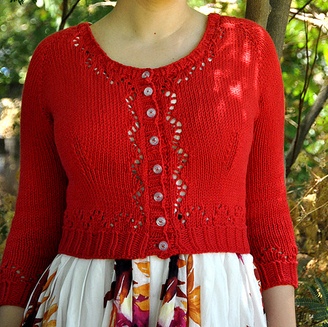
“I’ve knit many top down baby sweaters but never one for myself. I’d like to knit the sweater below. A question I have are the sleeves. Top down sleeves tend to look a bit baggy. Is there anything I can do to make it less so?”
The sweater in question is Miette, a free Ravelry pattern by Andi Satterlund. The gold version is the picture Ingrid sent, and while it is a lovely piece of knitting, you can clearly see there is some extra fabric under the arms. The red version is from the pattern.
The important parts of the description: “…seamless top down construction. Sizes: 34” (38”, 42”) finished bust sizes. Pattern is intended to be worn with 2” of negative ease.”
So this is your basic top-down raglan, with some eyelet detail in the first few rows, and then it settles down into the usual 4 sets of paired increases. Ingrid writes that she thinks top-down sleeves often look baggy, but in reality, it’s the raglan construction that usually does it, whether it’s knitted top-down or bottom-up — although top-down is a little more prone to it, and we’ll see why shortly.
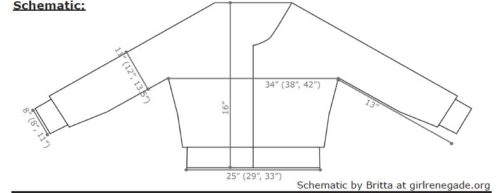 Looking at the schematic, the garment has three finished bust sizes, and says it is designed to be worn with 2″ of negative ease. So that means these sizes are meant to fit a 36″, 40″ and 44″ bust, respectively. (From here on out I am mostly going to discuss numbers for one size, but the ideas apply to all sizes.)
Looking at the schematic, the garment has three finished bust sizes, and says it is designed to be worn with 2″ of negative ease. So that means these sizes are meant to fit a 36″, 40″ and 44″ bust, respectively. (From here on out I am mostly going to discuss numbers for one size, but the ideas apply to all sizes.)
The Problem
Here’s the basic problem, and it’s one that is built in to the raglan shape: if you do raglan increasing until your yoke width (front + back) is equal to your bust measurement, and you are larger than a B cup or so, you will have extra fabric at the underarm. Guaranteed.
Mostly because your boobs are not at your underarm.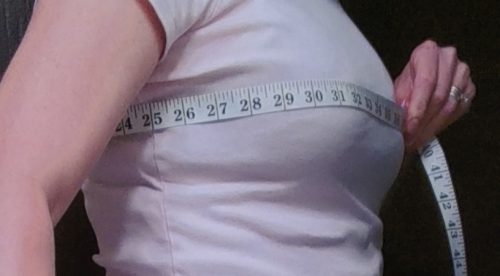
Take a good look, ladies. When you measure the fullest part of your bust, is that tape in your armpit? Heck no. It’s a few inches below. And this has nothing to do with boob size or body weight. Boobs simply aren’t situated at the armpit.
At your underarm, what you are trying to wrap knitting around is your upper chest, not your boobs.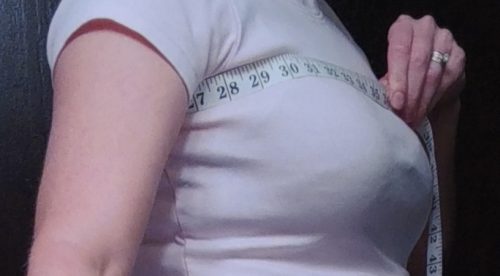
I am a B cup, and on me these two measurements are the same. But as cup size increases, I think we can all imagine that the bust measurement can become quite a bit larger than the upper chest measurement — and if you wrap that much fabric around the upper chest, you’re going to have extra fabric in your armpit.
I am guessing that the negative ease called for in this pattern is an attempt to counteract this problem, but that’s just a guess. Looking at the pictures in the pattern, it is clear that the sweater on the model does not actually have this negative ease: these two pictures show that it is loose across her upper back, and it has extra fabric under the arms. If I am right about that guess, the problem is that negative ease isn’t the right way to fix this, and it doesn’t quite go far enough.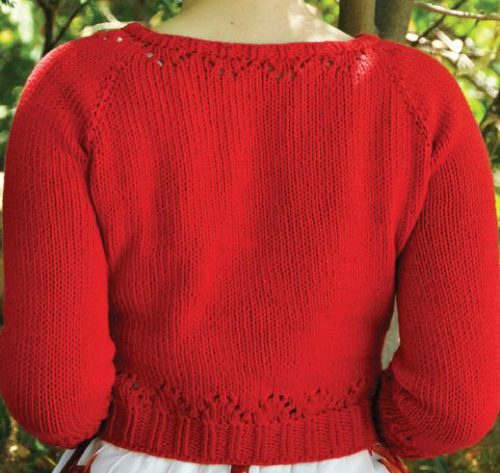
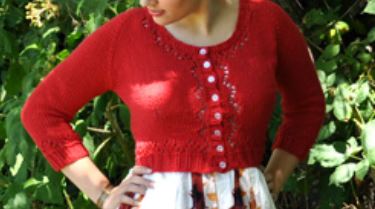 Let me stress again that this is the nature of the raglan beast. The raglan armhole is not a fitted armhole, and it wasn’t meant to be. For one thing, it was designed by a man, for a man, and if legend is correct, the point of it was to give that man a roomy armhole.
Let me stress again that this is the nature of the raglan beast. The raglan armhole is not a fitted armhole, and it wasn’t meant to be. For one thing, it was designed by a man, for a man, and if legend is correct, the point of it was to give that man a roomy armhole.
The standard raglan yoke, knit to the full bust measurement of anyone with boobs, yields at best a sweatshirt-y kind of fit.
This unfortunate state of affairs is complicated by knitters who historically have often been afraid of knitting anything too small and tight — we won’t get into a discussion here about body image and what wonderful things Hollywood and Madison Ave have done for us all there.
PLUS there is the fact that at the critical juncture, a bottom-up raglan knitter has the maximum chest size already determined for her, and all she has to do is decrease away to the neckline. But a top-down raglan knitter has to decide when to stop increasing, and she can easily talk herself into “just another few rounds, to be on the safe side”.
Knitting stretches, but my experience over a decade of teaching is that knitters don’t believe it. Negative ease has NOT been a knitting thing until fairly recently. Even my beloved Barbara Walker’s top-down raglan recommendation is enormous: she recommends knitting that yoke until the raglan line is “at least one or two inches below the underarm.” Holy crap. I think we can all figure out that that is NOT going to be a fitted armhole. It’s going to be a tent.
The Solution
So what can you do if that’s not what you want?
Well, you can choose another pattern with a fitted armhole — but we all love knitting raglan shaping because it’s EASY, right?
So — what you can do is not knit the yoke so damned big. And then add in some underarm ease, instead of a lot of extra yoke (and probably an extra ball of yarn).
The first sketch below shows what a fitted armhole curve looks like in sewing (black), and a knitted approximation of it (orange). This is the shape you are creating when you are knitting a garment in flat pieces, and the pattern tells you to “bind off X stitches at the beginning of the next 2 rows, then do some decreases at either end, then knit even until the armhole measures Y.”

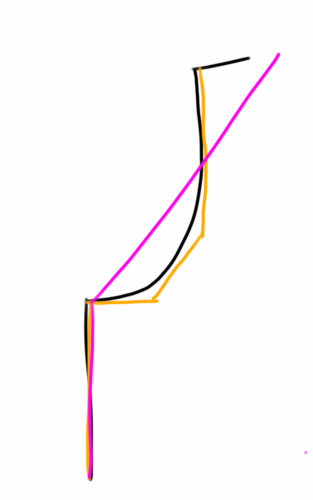
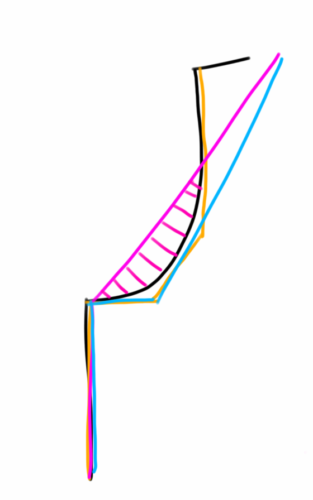
That flat part right at the beginning, where you bind off several stitches, is called “underarm ease”. But Ingrid’s pattern choice does not include any underarm ease — that is, there are no additional stitches cast on at the underarm when the body is all joined together, and instead the raglan lines go all the way under the arm and converge in the armpit. This is the pink line in the second sketch. What do you see? I see a lot of extra fabric in the underarm area. See the pink cross-hatched area in the third sketch?
Now, compare that to the photo of the gold version of the sweater: see what that extra fabric does?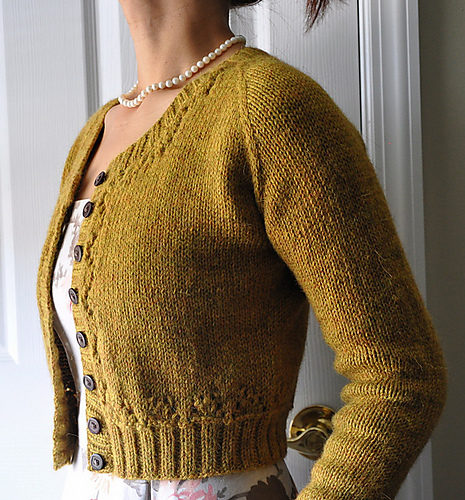
(You may notice that if the pink hatched area is “extra” fabric, then the top half of the raglan armhole would appear to have “missing” fabric. But this area at the top of the armhole is filled in by the raglan sleeve cap, which is much larger than a standard fitted sleeve cap.)
Solution: The first step towards a better-fitting raglan armhole is the blue line in the third sketch.
So how do we knit the blue line version?
You knit the yoke not to meet under the arms, but only until it fits your upper chest — and I usually do it with zero added ease. I want it to fit, not be tight or baggy. You then add underarm ease, and finally add some vertical bust darts, if needed — don’t worry, they are easy! — to accommodate the girls.
An Example
Desired upper chest measurement: 36″
Standard underarm ease: for smaller women’s sizes, the standard is 2″ per underarm. For larger women’s sizes, allow 3″ per underarm.
Subtract two underarms from the upper chest measurement: 36″ – 2″ – 2″ = 32″
Divide this in half, for front and back: 32 / 2 = 16″
As a double check, measure across your chest (not boobs!) at the underarms, and see how this fits. You should be able to hold either end of the tape slightly under your armpits with your thumbs. (Believe me, this was a tricky picture to take.)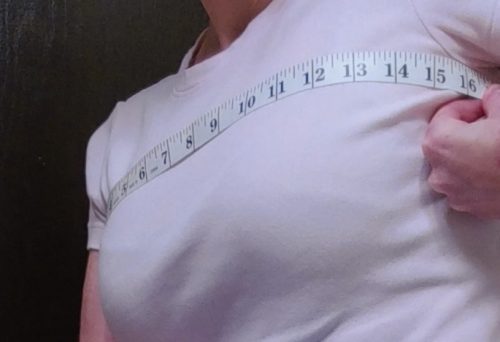
So you’re going to knit your raglan yoke until it measures this much (16″) across the back. You can’t measure across the fronts, because it’s a cardigan with an added-on button band. But the back should be the same. You can save yourself a lot of measuring time by making a quick estimate of how many stitches this will be: the pattern gauge is 16 sts over 4 inches, so it’s 4 sts per inch. 16″ x 4 sts per inch = about 64 sts across the back should get you there. When you do get there, try the whole thing on, and make sure you get the underarm depth you need at this proper cross-chest width. If you have to add a few rounds to get the underarm a little deeper, no worries, but don’t go overboard.
Then you will split up the body and sleeves, and start working the body. On the first round, you will CAST ON at each underarm the amount you subtracted out earlier for underarm ease – in this example, 2″ worth of stitches at each underarm, which we can easily calculate is 8 stitches added at each underarm.
Vertical Bust Darts
OK, so far, so good. Make a note that you will probably have to adjust some sleeve numbers later – and you will need to knit up those same 8 additional stitches under each arm when you start each sleeve – but that shouldn’t be too big of a deal.
Now we have to make some room for the girls. To start with, place a couple of stitch markers: one in the middle of each set of your 8 new underarm stitches. We are going to add stitches on the FRONT SIDE ONLY of both of those stitch markers, until we get enough additional room.
How much is enough? Well, again, if I am making something fitted, I am likely to use zero ease, or a SMALL amount of positive ease added to the full bust measurement, as my finished bust measurement goal. For this exercise, let’s say I’m now aiming for a 38″ full bust circumference, the middle size on the pattern (disregarding the bit about the negative ease, since I think that’s (a) in there for the wrong reason and (b) obviously not the case on the modeled sweater).
On a cardigan with an added band, we can’t just count stitches, or try it on and see. Well, actually, we can, if we know how wide that band is going to be — but in this case, the schematic does not tell us. The pattern says there are only 5 rows in one button band, so we could calculate that 5 rows, at 22 rows over 4 inches, is going to be a little less than an additional inch. And, as long as we’re looking at the band instructions, it’s worth noting that the band can easily be made a little wider if we need to, at the end, which is nice insurance to have.
So we do it with math instead.
- We left off with the proper amount of stitches for a 36″ finished upper chest measurement.
- We want to hit a 38″ finished full bust measurement, so we need to add a total of 2″ of width (8 sts total)
- Each increase row is going to add 1 stitch on either side of the front, so each increase row gets us an additional 2 sts, or half an inch.
- Therefore we only need 4 increase rows to get our extra 2″.
- Doing them on RS rows, or every other row, means we need 8 rows to get them in place.
You don’t want to start doing them too soon, though, or you’ll just have extra fullness under the arms in a different way. The full bust point is probably at least 2″ down from the underarm, which is 11 rows. So I’d probably work 2 or 3 rows even, depending if I left off on a RS row or a WS row, before I started those increases.
But what if you need a LOT more room? Let’s say we need 42″ at the full bust. That’s an additional 6″ of fabric from our current 36″.
- We need 24 extra stitches, or 12 on each side.
- A fuller bust does usually mean that the maximum fullness is a little lower — so let’s say we want to get to 42″ by the time we are 3″ below the underarm, which is about 16 rows.
- At 2 increases every other row, we’d need 24 rows and we don’t have them.
- Here, the solution is to throw in the extra increases on the purl rows. In 16 rows, you can get in 8 of the 12 increase pairs you need on the RS rows. So, you just need to ALSO increase on 4 purl rows in between.
Finally, you can choose to either decrease out the additional stitches once you get below the bust, or leave them in. Totally up to the knitter. I’ll point out that the original design includes what appear to be some decorative decreases, right at the bust. This is fine for the woman modeling the red sweater, but if you have a bountiful bust, you may not want those lovely eyelets drawing THAT much attention to your curves. In that case, they would maybe be better placed further below the bust, or, the the knitter who made the gold sweater appears to have left them out entirely. Knitter’s choice!
Thanks, Ingrid, for a great question to start off with!
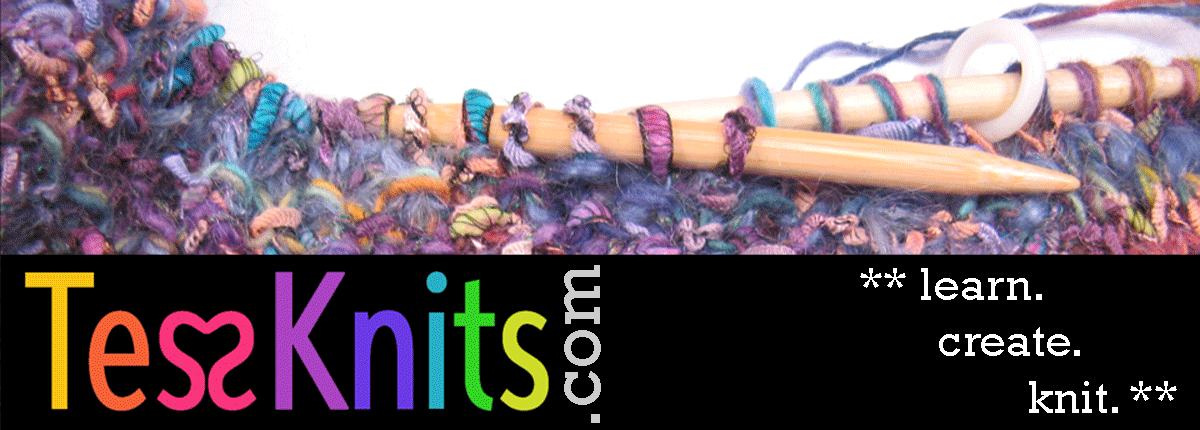
18 comments for “Ask the Knitting Teacher: What Can I Do About Baggy Raglan Sleeves?”